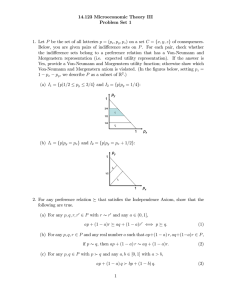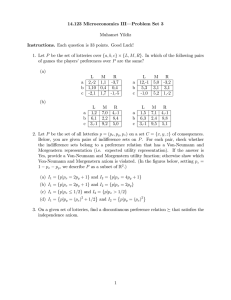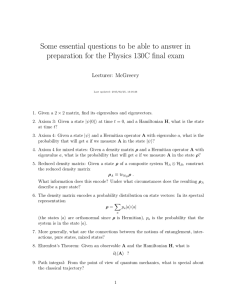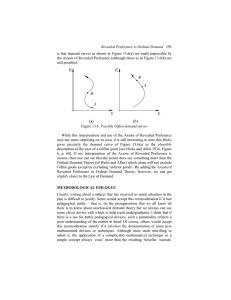Document 13435869
advertisement
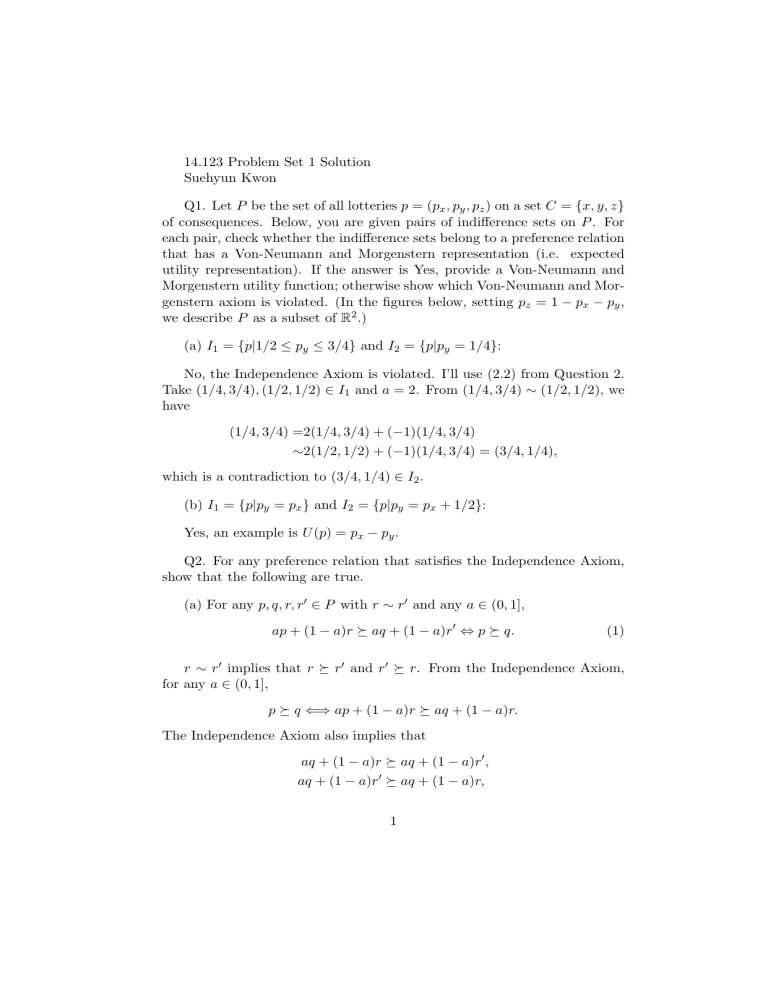
14.123 Problem Set 1 Solution
Suehyun Kwon
Q1. Let P be the set of all lotteries p = (px , py , pz ) on a set C = {x, y, z}
of consequences. Below, you are given pairs of indifference sets on P . For
each pair, check whether the indifference sets belong to a preference relation
that has a Von-Neumann and Morgenstern representation (i.e. expected
utility representation). If the answer is Yes, provide a Von-Neumann and
Morgenstern utility function; otherwise show which Von-Neumann and Mor­
genstern axiom is violated. (In the figures below, setting pz = 1 − px − py ,
we describe P as a subset of R2 .)
(a) I1 = {p|1/2 ≤ py ≤ 3/4} and I2 = {p|py = 1/4}:
No, the Independence Axiom is violated. I’ll use (2.2) from Question 2.
Take (1/4, 3/4), (1/2, 1/2) ∈ I1 and a = 2. From (1/4, 3/4) ∼ (1/2, 1/2), we
have
(1/4, 3/4) =2(1/4, 3/4) + (−1)(1/4, 3/4)
∼2(1/2, 1/2) + (−1)(1/4, 3/4) = (3/4, 1/4),
which is a contradiction to (3/4, 1/4) ∈ I2 .
(b) I1 = {p|py = px } and I2 = {p|py = px + 1/2}:
Yes, an example is U (p) = px − py .
Q2. For any preference relation that satisfies the Independence Axiom,
show that the following are true.
(a) For any p, q, r, r' ∈ P with r ∼ r' and any a ∈ (0, 1],
ap + (1 − a)r C aq + (1 − a)r' ⇔ p C q.
(1)
r ∼ r' implies that r C r' and r' C r. From the Independence Axiom,
for any a ∈ (0, 1],
p C q ⇐⇒ ap + (1 − a)r C aq + (1 − a)r.
The Independence Axiom also implies that
aq + (1 − a)r C aq + (1 − a)r' ,
aq + (1 − a)r' C aq + (1 − a)r,
1
and we have
ap + (1 − a)r C aq + (1 − a)r =⇒ ap + (1 − a)r C aq + (1 − a)r' ,
ap + (1 − a)r C aq + (1 − a)r' =⇒ ap + (1 − a)r C aq + (1 − a)r
by transitivity.
p C q ⇐⇒ ap + (1 − a)r C aq + (1 − a)r' .
(b) For any p, q, r ∈ P and any real number a such that ap+(1−a)r, aq +
(1 − a)r ∈ P ,
if p ∼ q, then ap + (1 − a)r ∼ aq + (1 − a)r.
(2)
The case a ∈ (0, 1] is given by the Independence Axiom, and the case
a = 0 always holds from r ∼ r.
For a > 1, 1/a ∈ (0, 1], and the Independence Axiom gives that
ap + (1 − a)r ∼ aq + (1 − a)r
1
a−1
1
a−1
⇐⇒ (ap + (1 − a)r) +
r ∼ (aq + (1 − a)r) +
r
a
a
a
a
⇐⇒p ∼ q.
For a < 0, 1/(1 − a) ∈ (0, 1], and if p ∼ q,
1
−a
1
(ap + (1 − a)r) +
q∼
(ap + (1 − a)r) +
1−a
1−a
1−a
∼r
1
∼
(aq + (1 − a)r) +
1−a
−a
p
1−a
−a
q.
1−a
By the Independence Axiom, we have
ap + (1 − a)r ∼ aq + (1 − a)r.
Therefore, for any a ∈ R such that ap + (1 − a)r, aq + (1 − a)r ∈ P ,
if p ∼ q, then ap + (1 − a)r ∼ aq + (1 − a)r.
(c) For any p, q ∈ P with p > q and any a, b ∈ [0, 1] with a > b,
ap + (1 − a)q > bp + (1 − b)q.
2
(3)
If b = 0, the Independence Axiom gives that
ap + (1 − a)q > aq + (1 − a)q ∼ q.
For b > 0, we have b/a ∈ (0, 1), and
ap + (1 − a)q > q
b
a−b
=⇒ ap + (1 − a)q ∼ (ap + (1 − a)q) +
(ap + (1 − a)q)
a
a
b
a−b
> (ap + (1 − a)q) +
q ∼ bp + (1 − b)q.
a
a
(d) There exist cB , cW ∈ C such that for any p ∈ P ,
cB C p C cW .
(4)
[Hint: use completeness and transitivity to find cB , cW ∈ C with cB C c C
cW for all c ∈ C; then use induction on the number of consequences and the
Independence Axiom.]
The set of consequences C is finite. Let n be the number of consequences.
When n = 1, cB ∼ p ∼ cW for all p ∈ P .
Suppose that for n = k, there exist cB , cW ∈ C such that for any p ∈ P ,
cB C p C cW .
(∗)
Consider n = k+1. Let C = {c1 , · · · , ck+1 } and C ' = {c1 , · · · , ck }. From
'
'
'
'
'
(∗), there exist cB , cW ∈ C ' such that cB C p' C cW . If ck+1 > cB , let
'
'
'
cB = ck+1 , cW = cW . If cW > ck+1 , let cB = cB , cW = ck+1 . Otherwise,
'
'
cB = cB , cW = cW . Any p ∈ P can be written as p = ap' + (1 − a)ck+1 for
some a ∈ [0, 1] and a lottery p' over C ' = {c1 , · · · , ck }.
We have cB C p' , ck+1 C cW , and by the Independence Axiom,
cB C ap' + (1 − a)cB
C ap' + (1 − a)ck+1 = p
C ap' + (1 − a)cW
C cW .
Q3. Let P be the set of probability distribution on C = {x, y, z}. Find
a continuous preference relation C on P , such that the indifference sets are
all straight lines, but C does not have a von Neumann-Morgenstern utility
representation.
3
Consider a preference relation represented by the following utility func­
tion
py
U (px , py , pz ) =
.
2 − px
C is complete, transitive and continuous, and the indifference set are
straight lines, but the Independence Axiom is not satisfied.
Q4. Let C be the ”at least as likely as” relation defined between events
in Lecture 3. Show that C is a qualitative probability.
From P 1, C is a preference relation, which implies that it’s complete and
transitive.
The second part follows from
'
'
B C C ⇐⇒ fBx,x C fCx,x for some x, x' ∈ C, x > x'
'
'
x,x
x,x
⇐⇒ fB∪D
C fC∪D
(: P 2)
⇐⇒ B ∪ D C C ∪ D.
Lastly, from P 4, there exists x, x' ∈ C with x > x' . For any event B,
'
x > x' =⇒ fBx,x C f∅x,x
'
(: P 2)
⇐⇒ B C ∅.
'
'
Given any x, x' ∈ C with x > x' , we have fSx,x C f∅x,x from P 2. There
'
'
exist no x, x' ∈ C with x > x' such that f∅x,x C fSx,x .
S C ∅, ∅ ' S =⇒ S > ∅.
4
MIT OpenCourseWare
http://ocw.mit.edu
14.123 Microeconomic Theory III
Spring 2015
For information about citing these materials or our Terms of Use, visit: http://ocw.mit.edu/terms .
